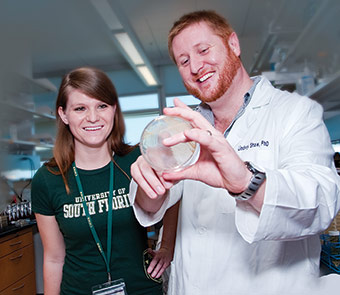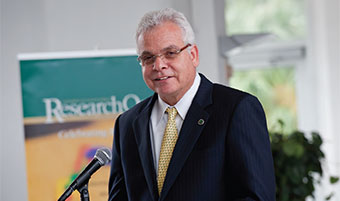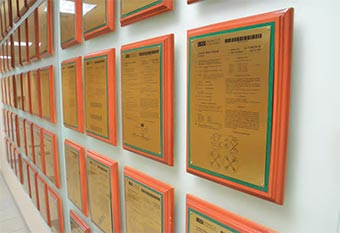Feature
Driving Innovation
| USF News

Photo by Aimee Blodgett | USF News
As a teenager growing up in England, Lindsey "Les" Shaw was captivated by bacteria, so much so that he devoted his high school science project to finding ways to kill the ubiquitous microorganisms.
Shaw's motivation came from within. For nearly five years he struggled with a classic hospital-acquired bacterial infection following surgery to treat a developmental hip condition.
Today Shaw, 35, is a molecular biologist and associate professor in the Department of Cell Biology, Microbiology and Molecular Biology at USF. He is a preeminent researcher in the field of bacterial pathogenesis, and one of only 3 percent of NIH awardees to serve as principal investigator on an R01 research grant before the age of 36.
Shaw is part of the world-class research enterprise at USF — an enterprise that has seen unprecedented growth in recent years.
In the 2011-2012 academic year, USF broke the $400 million mark for research awards, earning more than $411 million in total awards and contracts. The university ranks 10th worldwide among universities granted U.S. patents, according to the Intellectual Property Owners Association. And in the latest rankings by the National Science Foundation, USF was ranked among the top 50 universities in the nation, public or private, for research expenditures.
"We have transitioned into a major research institution in the last 10 years," says Paul R. Sanberg, vice president for Research & Innovation at USF, and a leading neuroscience researcher with about 100 health-related U.S. and foreign patents. "Research and innovation have become very inherent in our culture."
USF researchers today are advancing the frontiers of medicine, science, engineering and the arts. The university is a leader in the study and treatment of brain disease; veterans reintegration and resilience; sustainability; infectious disease; and photovoltaic technologies — using cells to transfer energy from sunlight. The USF Pediatric Epidemiology Center, the data and technology coordinating hub for nearly every major Type 1 diabetes clinical trial worldwide, has become the epicenter for global juvenile diabetes research under the direction of Jeffrey Krischer.
It's no accident, Sanberg says. USF is investing heavily in research and scholarly work. The university is aggressively pursuing out-of state grants and research contracts, promoting interdisciplinary collaboration and turning the spotlight on technology transfer — bringing scientific discoveries to market.
Ideal research environment
It's the ideal environment for researchers like Shaw, whose work is focused on the pathogenesis and epidemiology of Staphylococcus aureus, or MRSA, a bacterium notoriously adept at acquiring resistance to antibiotics. MRSA is a leading cause of human disease in the world today, and the most common cause of death by a single agent in the United States.
"USF was absolutely my first choice among American universities," says Shaw, who joined USF in 2007. "There's a massive push here for translational science — for developing new drugs. I knew I could make a difference."
"Every university talks about interdisciplinary science," he continues, "but it feels very forced. At USF, it's not. It's organic; it's in the system."
In his lab, Shaw works with other USF scientists — chemists and biologists — to develop novel antibiotics that can treat and kill MRSA. The team is making progress. "We have a couple of decent leads, a couple of patents on compounds."
Maximizing research success

Paul R. Sanberg, vice president for Research & Innovation at USF
Photo by Aimee Blodgett | USF News
The Office of Research & Innovation is dedicated to maximizing the success of USF researchers, like Shaw, and growing the research enterprise, even in times of uncertain funding.
"Our number one job is to support these researchers, even in compliance issues, to help them do these studies as efficiently as possible to create new knowledge," Sanberg says.
The office is also charged with protecting the intellectual property of the university.
It works closely with faculty in a number of important areas: Comparative Medicine; The Center of Excellence for Drug Discovery & Innovation; Patents & Licensing; Research Administration Education; Research Financial Management; Research Integrity & Compliance; Sponsored Research; the USF Research Foundation; the USF Research Park of Tampa Bay; and the Tampa Bay Technology Incubator. Each area plays a critical role in advancing research and innovation at USF.
"It's a very conducive and supportive environment," says USF neuroscientist Cesar Borlongan, a pioneer in stem cell therapy research, who investigates how adult stem cells harvested from bone marrow or umbilical cord blood can be prodded to repair stroke-damaged regions of the brain. The Office of Research & Innovation facilitates the administrative leg of Borlongan's research.
"It's a two-way street. Having open communication and good interaction between scientists and administrators creates a good environment," he says, an environment that breaks down barriers and promotes collaboration.
Ground-breaking translational research

USF neuroscientist Cesar Borlongan
Photo by Eric Younghans | USF Health
Borlongan and his colleagues at USF are challenging existing dogma — a long-held belief that the brain cannot be repaired.
"Our research is showing the potential of adult stem cells," he says, adding that his team is not interested in studying embryonic or fetal stem cells. "There is compelling evidence that adult stem cells are potent and able to become other types of cells — brain cells and bone cells."
Adult stem cells, Borlongan explains, are flexible. When coaxed, they can mimic other cell types. In the instance of stroke, the cells can be injected near the damaged area of the brain. The implanted cells get signals from the surrounding environment and can fill the missing block of cells, effectively repairing the damage.
"It's fascinating; it challenges the traditional view that adult cells are primarily committed to that type of cell," Borlongan says. "We are not trying to build new organisms. We are trying to repair damage to existing tissue."
The ground-breaking work is making its way from the laboratory into the clinic where it could have huge implications for human health.
Currently, seven clinical trials for adult stem cell therapy for treatment of stroke are under way in the U.S. Three of those trials are based on research at USF.
University-wide focus
In January, First Lady Michelle Obama praised USF's efforts to address the needs of military service members, veterans and their families through a research-based reintegration and resilience initiative.
The university's College of Nursing is conducting studies on post-traumatic stress disorder to improve the emotional health and quality of life for veterans with disabilities. Researchers in the School of Physical Therapy & Rehabilitation Sciences are working to improve prosthetic devices for soldiers and veterans who have lost limbs in combat, including young amputee soldiers who want the option of returning to the battlefield.
At USF's Global Center for Hearing & Speech Research, scientists are investigating new treatments and devices for veterans who have suffered speech and hearing loss. And, a multidisciplinary team of researchers is investigating novel treatments, such as hyperbaric oxygen therapy, for traumatic brain injury.
"We are doing so much," says Sanberg, adding, "We don't have the infrastructure of 100, 200 years. We are getting where we want to go with less means."
With less means and creative partnerships.
Partnerships to advance science

U.S. patents awarded to USF line the walls of the Technology Transfer Office in the USF Research Park.
Photo by Katy Hennig | USF News
The USF Research Park, located on the Tampa campus, links researchers to businesses in need of research partnerships. Occupancy in the park, which opened in 2008, is at 96 percent, with 37 resident and 35 affiliate companies focused on biotechnology and life sciences research and entrepreneurship.
The park is home to USF CONNECT, a network of innovation-based companies, research, government resources and business development tools, including the USF Research Foundation and the Tampa Bay Technology Incubator. The incubator program helps grow successful companies with a range of support services, such as access to USF researchers and critical costly research equipment. To date, TBTI has incubated more than 40 companies, creating 300-plus jobs in the region and more than 130 partnerships with USF faculty.
It's the kind of collaboration, Sanberg says, that "helps create jobs, brings innovation and new technologies to society faster, and introduces a sense of business, milestones and project management to the university setting."
It's the kind of collaboration that helps build an ever-stronger national research university and a powerful economic and intellectual driver for the state.
It's the kind of collaboration that changes lives.